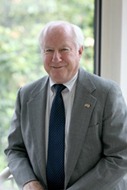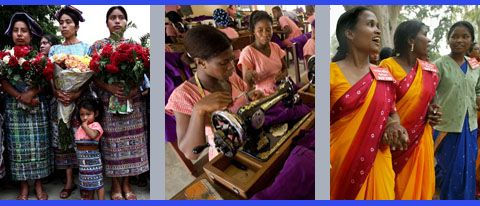Posted on May 17, 2010

Jim Kolbe, from the German Marshall Fund website
Jim Kolbe, former republican member of Congress and foreign aid champion, wrote on the German Marshall Fund’s blog that Congress may be the best hope for foreign aid reform. He points out that with all the delays in releasing the QDDR (the State Department’s review of development & diplomacy) and the appearance of major disagreement on aid reform principles between the White House, State Department, and USAID, Congress has an opportunity to take the helm and make aid reform actually happen.
Jim Kolbe is not the only one who senses the promise of reform leadership from Congress. Last week, his MFAN comrade Larry Nowels gave a talk on the foreign aid process here at Global Washington, and he cited agreement among key players in Congress as one of the reasons why the time is ripe for foreign aid reform.
Posted on May 13, 2010
 Do you have a great idea for a new approach to the political, economic, and social empowerment of women and girls around the world? On April 28th, Secretary Clinton announced a new award, funded through the Rockefeller Foundation, to find and bring to scale the most innovative programs to empower women and girls. Each awardee will receive a grant of up to $500,000 to implement their idea.
Do you have a great idea for a new approach to the political, economic, and social empowerment of women and girls around the world? On April 28th, Secretary Clinton announced a new award, funded through the Rockefeller Foundation, to find and bring to scale the most innovative programs to empower women and girls. Each awardee will receive a grant of up to $500,000 to implement their idea.
To apply, submit your concept paper to SGWIRFPInnovation@state.gov by June 1st, 2010. A jury panel will select a group of applicants to submit a full proposal, and select awardees by the end of the year.
For more information about this award, see the State Department’s Office of Global Women’s Issues website, where there are instructions and an FAQ about the award.
Posted on May 12, 2010
Written By Lindsey Engh of Lumana
Microfinance has a variety of outcomes. There are huge, best-case scenario outcomes that microfinance experts usually preach: escape from poverty, empower yourself, send all your children to school, invest in your business, create jobs, and access quality healthcare. Then there are smaller outcomes, such as ONE rural villager sending their child to school, or ONE person being able to expand their business based on a micro-loan. The best way to talk about these outcomes is by story-telling, or using qualitative methods such as interviews and group meetings to find out how microfinance has made an impact in the lives of individual clients. This is a very important part of outcome analysis in microfinance.
However, microfinance also has more economic and quantitative outcomes to measure as well. These include measuring net impact, like how much a client’s income has actually increased since receiving a micro-loan, or how much they are putting away for savings each month. These outcomes are hard to measure by story-telling, but are equally important.
In the past six months, the first two extensive and rigorous evaluations of the impact of microfinance have been published. One was done in India, lead by Esther Duflo and Abhijit Bannerjee of J-PAL the other in the Philippines led by Dean Karlan and Jonathan Zinman of IPA. The main research questions for both are centered around the question, ‘does access to microcredit have a significant impact on household expenditures and welfare?’ Their findings included both economic data and some story-telling, through a case by case approach.
Their findings? That microfinance has a positive, but mostly small impact. For example, access to microcredit has an important effect on household expenditure patterns and the creation and expansion of businesses, but no effect on health, education, and women’s decision making in the short term – which are the main qualitative, story-telling outcomes that has made microfinance so popular in the first place.
I have been discussing how transparency is important in microfinance. If followers believe that microfinance can change a client’s life by directly benefitting their health, education, and decision making, but data and other studies (such as the two above) shows that in the short-term, microfinance only really impacts a client’s income, this is not transparent. It’s important to show advocates and followers exactly what a loan can do for clients. That’s why it’s so important that Lumana has integrated both qualitative story-telling AND quantitative changes, such as aggregate household expenditure, to fully outline our impact and outcomes.
This week, six major microfinance organizations issued a response to these two studies. Several other bloggers and microfinance advocates found this response wanting, because they felt the general idea of the response stated that despite the news from these two rigorous, academic evaluations, they are going to continue telling nice stories and operating exactly as they have been, continuing to say that microfinance directly impacts health, education, and women’s decision-making, among other major poverty indicators.
It’s important to be realistic about the impacts of microfinance, in order to further innovate and progress the field. At Lumana, we believe that microfinance is an enabler – this means that microfinance can open the door to basic financial services, which we believe are the building blocks for any one person to start saving money and raising their income. However, we also believe that poverty is a definition for many other problems, such as a lack of health and sanitation rules, clean water, and education. Poverty is a complex puzzle.
That’s why it is important to share information and data, because it takes a lot of different knowledge and work to create a sustainable difference in the lives of developing communities. If an academic source comes out with an evaluation saying that microfinance, in itself, can only have a certain number of outcomes for an individual, then that information should be used to bring in other services or products to a developing area that can deliver those health, education, and decision making outcomes.
At Lumana, we believe that although we can’t solve all of the problems in the villages in which we work, we can share our knowledge of the area and our clients with other organizations who can help to solve those problems.
Saying that microfinance delivers only small outcomes isn’t a negative, or defeated, outlook on microfinance at all. It is a realistic view from a different source, meaning that microfinance delivers the basic financial infrastructure that is important to an individual’s well-being. We need a cadre of charities, donors and policymakers who will look at rigorous evidence that shows small gains and celebrate, not lament—and then look at the data again to see how we can extend or expand those small benefits.

